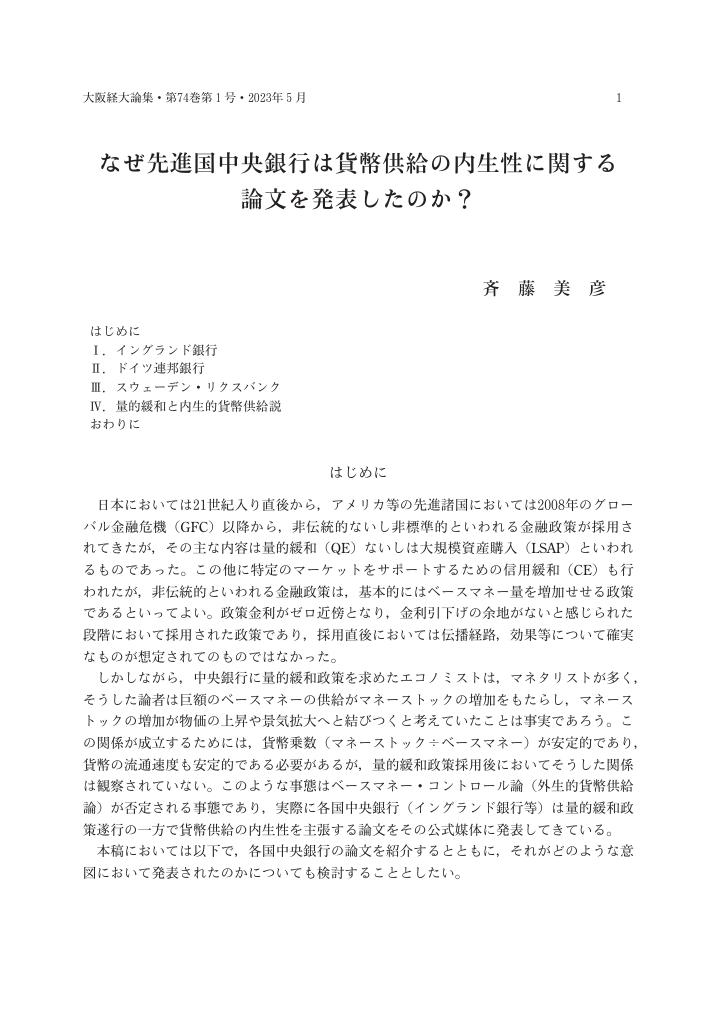11 0 0 0 OA 内生的貨幣供給説と中央銀行の金融調節(書評へのリプライ)
- 著者
- 斉藤 美彦
- 出版者
- 経済理論学会
- 雑誌
- 季刊経済理論 (ISSN:18825184)
- 巻号頁・発行日
- vol.44, no.3, pp.93-95, 2007-10-20 (Released:2017-04-25)
9 0 0 0 OA 内生的貨幣供給説としての「日銀理論」:再論
- 著者
- 斉藤 美彦
- 出版者
- 大阪経大学会
- 雑誌
- 大阪経大論集 (ISSN:04747909)
- 巻号頁・発行日
- vol.72, no.2, pp.71-85, 2021 (Released:2021-07-28)
9 0 0 0 内生的貨幣供給説としての日銀理論--量的緩和論批判に至る系譜
- 著者
- 斉藤 美彦
- 出版者
- 広島県立大学
- 雑誌
- 広島県立大学論集 (ISSN:13431684)
- 巻号頁・発行日
- vol.4, no.1, pp.55-73, 2000-08
6 0 0 0 OA なぜ先進国中央銀行は貨幣供給の内生性に関する論文を発表したのか?
- 著者
- 斉藤 美彦
- 出版者
- 大阪経大学会
- 雑誌
- 大阪経大論集 (ISSN:04747909)
- 巻号頁・発行日
- vol.74, no.1, pp.1-21, 2023-05-15 (Released:2023-05-31)
- 著者
- 斉藤 美彦
- 出版者
- 日本証券経済研究所
- 雑誌
- 証券経済研究 (ISSN:13421476)
- 巻号頁・発行日
- no.98, pp.1-17, 2017-06
3 0 0 0 IR 国債累積と金融システム・中央銀行
- 著者
- 斉藤 美彦
- 出版者
- 成城大学
- 雑誌
- 経済研究所年報 (ISSN:09161023)
- 巻号頁・発行日
- no.25, pp.43-69, 2012-04
2 0 0 0 OA 内生的貨幣供給説への到達とその深化:吉田金融論の形成過程
- 著者
- 斉藤 美彦
- 出版者
- 大阪経大学会
- 雑誌
- 大阪経大論集 (ISSN:04747909)
- 巻号頁・発行日
- vol.74, no.2, pp.1-20, 2023-07-15 (Released:2023-08-03)
- 著者
- 斉藤 美彦
- 出版者
- 千葉商科大学
- 雑誌
- CUC view & vision (ISSN:13420542)
- 巻号頁・発行日
- no.39, pp.12-18, 2015-03
1 0 0 0 国債累積と金融システム(<特集>国債累積下の現代経済)
- 著者
- 斉藤 美彦
- 出版者
- 経済理論学会
- 雑誌
- 季刊経済理論 (ISSN:18825184)
- 巻号頁・発行日
- vol.43, no.3, pp.15-26, 2006
In fiscal 1965, the Japanese Government could not continue to balance the budget and started to issue government bonds. Gross debt of the national government grew rapidly following the first oil crisis. Consequently, Japanese banks and the Bank of Japan have greatly increased their holdings of government bonds. The Bank of Japan, in particular, has had to increase the amount of outright purchases of long-term government bonds since the introduction of the quantitative easing policy in March 2001. Recently, many market participants and economists argue that a largely treasury-only portfolio of central banks would be appropriate as the markets for government bonds are large and liquid. This paper first examines the course of this large increase in the outright purchase of government bonds by the Bank of Japan, and then looks at a popular belief that the issuance of central bank notes should be supported by long-term government bonds. In addition, the paper shows that this popular belief is premised on the specific historical condition of the fiscal deficit. The paper also looks at the relationship between orthodox monetary policies and the accumulation of government bonds. The paper does not follow the old argument that central banks should hold only gold, foreign exchange and real bills, rather, it contends that the main issue is the way contemporary capitalism, financial systems and monetary policies are analyzed. Japan's future fiscal condition will be severely affected by its ageing society and the apparently ever increasing strength of the Yen. Under such circumstances, the Bank of Japan is likely to be under pressure to maintain the price of long-term government bonds and thereby keep long term interest rates low. Such a policy is likely to affect central bank independence, a very dangerous prospect. Finally, this paper emphasizes that central bank notes are not supplied exogenously. Private sector banks supply money (deposits) endogenously and people obtain central bank notes by withdrawing deposits. The demand for central bank notes is a part of the total demand for monetary aggregates supplied by private sector banks. The relationship, therefore, between the accumulation of government bonds and the structure of balance sheets of central banks concerns the overall contemporary financial systems.
1 0 0 0 OA 内生的貨幣供給説と中央銀行の金融調節(書評へのリプライ)
- 著者
- 斉藤 美彦
- 出版者
- 経済理論学会
- 雑誌
- 季刊経済理論 (ISSN:18825184)
- 巻号頁・発行日
- vol.44, no.3, pp.93-95, 2007-10-20
- 著者
- 斉藤 美彦
- 出版者
- 証券経済学会事務局
- 雑誌
- 証券経済学会年報 (ISSN:03881458)
- 巻号頁・発行日
- no.49, pp.244-249, 2014-07
1 0 0 0 IR イギリスにおける金融危機と国債管理政策 (春井久志博士退職記念号)
- 著者
- 斉藤 美彦 Yoshihiko Saito
- 出版者
- 関西学院大学経済学部研究会
- 雑誌
- 経済学論究 (ISSN:02868032)
- 巻号頁・発行日
- vol.68, no.1, pp.87-110, 2014-06
1 0 0 0 金融危機下のイングランド銀行金融政策
- 著者
- 斉藤 美彦
- 出版者
- 日本証券経済研究所
- 雑誌
- 証券経済研究 (ISSN:13421476)
- 巻号頁・発行日
- no.76, pp.41-61, 2011-12
1 0 0 0 イングランド銀行の量的緩和政策の評価と今後の展望
- 著者
- 斉藤 美彦
- 出版者
- 日本証券経済研究所
- 雑誌
- 証券レビュー (ISSN:13406809)
- 巻号頁・発行日
- vol.53, no.8, pp.70-108, 2013-08
- 著者
- 斉藤 美彦
- 出版者
- 日本証券経済研究所
- 雑誌
- 証券経済研究 (ISSN:13421476)
- 巻号頁・発行日
- no.82, pp.1-20, 2013-06




